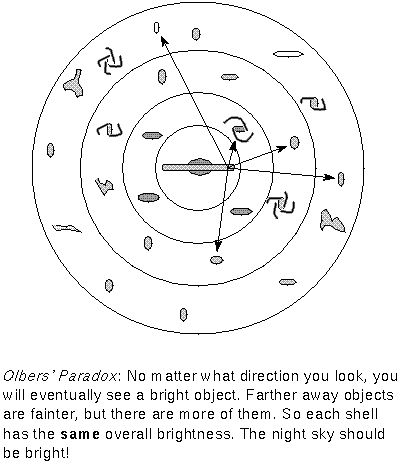1. Static
2. Centre less
3. Infinite
4. Based on mathematical laws of motion and gravitation
5. Infinitely aged
The Newtonian universe is infinite in size and contains an infinite number of stars.

At the first instant, the Newtonian model of the universe seems to provide satisfactory explanations of almost all the celestial phenomena but if closely inspected, the Newtonian model offers some serious flaws!!
One of the consequences of the Newtonian model is that the night sky should have never been dark! According to our observation, the night sky is dark; atleast the spaces between the stars are dark. This is not surprising at the first thought. At night we are on the side of the earth that points away from the sun, it is bound to be dark, isn’t it? Actually it is not as obvious as that. Infact it is very difficult to explain why the sky at night is dark on the basis of the Newtonian model.
If, as par the Newtonian model, we consider that the universe is infinitely sized with infinite stars that maintain a certain distribution pattern, we can easily assign a number, say N, to the number of stars per unit volume of space. The volume of a spherical shell of space centred on the earth is ∆R*4πR2 where R is the distance of a shell of thickness ∆R which is at a distance R from the centre of the earth. If the stars are uniformly distributed, the number of stars in each shell is proportional to R2. The light emitted from a shell is thus proportional to R2. But light obeys inverse square law getting weaker with distance, in proportion to (1/R2). So each shell produces the same intensity of light at the earth. If there are infinite numbers of shells, i.e. if the universe is infinitely large, then the night sky should be infinitely bright!
This seemingly possible yet unobserved phenomenon is often named the OLBERS’ PARADOX.

The resolution to the paradox can be brought about very simply. First of all, it is very difficult to ascertain whether the universe is finite or infinite. Let’s keep this as a query to the best of the minds and proceed with the fact that the universe is infinitely large. Still we can solve the paradox! Until very recently, scientists like Edwin Hubble formulated laws like the Hubble’s law and made it sure that there is a particular age of the universe and thus it is not of infinite age. At any moment we are only receiving light from a finite number of stars. Light from others is still on its way to us (because they are very far from us and since the universe is not infinitely aged, the light from these stars did not get enough time to reach us). The overall effect is that we are continuously seeing light from the equivalent of a spherical shell of stars that is not wide enough to cover the entire sky. This explains why gaps between stars are dark.
More to be found in Hubble’s law is that distant stars recede from the earth at very high speeds than the less distant ones. This causes the energy from these stars to be red shifted sufficiently that by the time they reach the earth, they are no more in the visible range. Hence light from those stars can never be seen. If however, it becomes clear that the universe is finitely sized, it would rather reinforce the arguments put above to prove why the night sky is dark.

These inferences have serious consequences other than resolving Olbers’ paradox. The presence of visually undetected radiations in the universe suggests that there might be radiations reaching the earth’s surface now, that were emitted by stars and galaxies that once existed right after the birth of the universe. These radiations might hold important and intriguing information about the elemental compositions of celestial bodies right after the big bang and might often lead us into knowing why the big bang occurred in the first place!
----
By Mahmud Hasan
The Aftermath Publications.
----
The Aftermath Publications, Issue 4
----












1 comment:
Grat and easy explanation of Olbers' Paradox!
Post a Comment
Please comment and question about the content of the post.